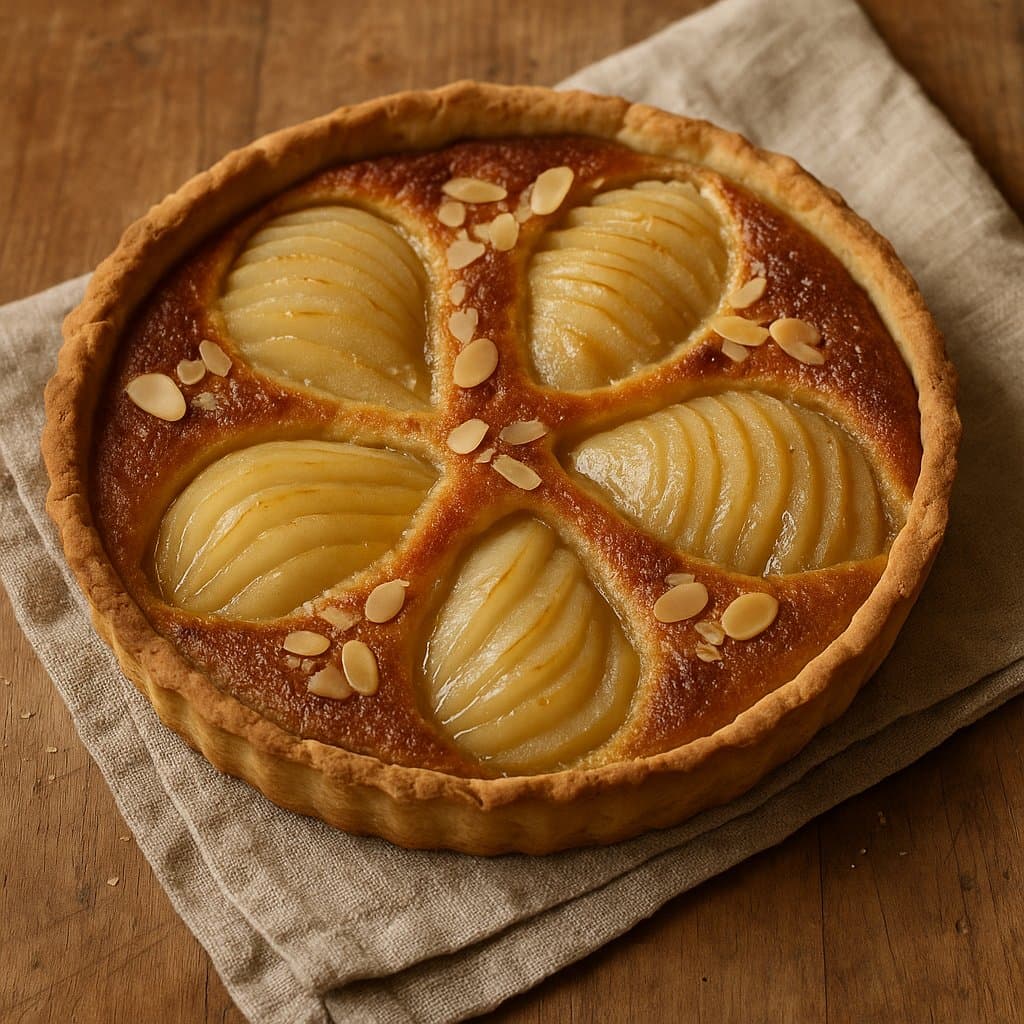The Forgotten Origins of Tarte Bourdaloue, Paris’ Quietly Iconic Tart

The Forgotten Origins of Tarte Bourdaloue, Paris’ Quietly Iconic Tart
Around the World in 80 Bakes: Stop #21 — France
In the heart of 19th-century Paris, where wide boulevards met gas-lit bakeries and window displays sparkled with golden pastries, a new tart quietly made its debut — elegant, seasonal, and utterly French. It wasn’t a grand cake for kings or a regional rustic pie. It was something in between: a tart of poached pears and almond cream, carefully arranged in a sweet pastry shell. Its name? Tarte Bourdaloue.
Named after a street, not a person, this tart is both a product of its time and a reminder of how humble ingredients — fruit, almonds, butter — can be elevated into a thing of grace.
A Street in Paris
The tart takes its name from Rue Bourdaloue, a street in the 9th arrondissement of Paris. The street itself was named after Louis Bourdaloue (1632–1704), a famous French Jesuit preacher at the court of Louis XIV. But the tart didn’t emerge during the Sun King’s reign — it came more than a century later, during the Belle Époque.
Sometime in the mid to late 1800s, a pâtissier working on Rue Bourdaloue — widely believed to be from the Pastry House Lesserteur — created this tart by layering poached pears onto frangipane (almond cream), all nestled into pâte sucrée (sweet shortcrust). It was simple yet refined. Pears were in season, frangipane was popularised during the rise of classic pâtisserie, and Paris was ready for something new to serve at the table with coffee or tea.
What set the tart apart wasn’t just its flavour, but its visual balance: fan-sliced pears arranged symmetrically, often dotted with slivered almonds or brushed with apricot glaze. In many ways, it was a pâtissier’s response to the painter’s canvas — a dessert that pleased both the palate and the eye.
But First — What is Frangipane?
The use of frangipane in French desserts predates the tart by at least two centuries. The name is thought to come from Marquis Muzio Frangipani, an Italian nobleman in the 16th century who supposedly introduced an almond-scented perfume used in gloves. French pastry chefs, ever inspired by fragrance and refinement, applied the name to an almond-flavoured cream made of butter, sugar, eggs, and ground almonds.
This almond cream became a building block of many French classics — Galette des Rois, Pithiviers, and various fruit tarts. It was rich, aromatic, and just luxurious enough to feel festive without being excessive.
By the 19th century, Parisian pastry chefs were blending frangipane with seasonal fruits like plums, apricots, cherries, and of course — pears.
🍐 A Dessert of Its Time
Tarte Bourdaloue emerged during a time when bourgeois households were embracing the rituals of afternoon tea, dessert carts, and pâtisserie boxes. This wasn’t a bake meant for peasant ovens or rural feasts — it was born in the urban salons of Paris, designed to impress guests, yet remain light and graceful.
It was also a reflection of what was available:
– Pears were abundant in French orchards, especially the buttery Williams and floral Comice.
– Almonds were a luxury staple brought in from Provence or imported from Italy and Spain.
– Pâte sucrée, a sweet, buttery dough, had become common in Parisian kitchens thanks to formalised recipes by chefs like Marie-Antoine Carême earlier in the century.
The tart’s widespread popularity meant that variations began to emerge, some with custard added, others with chocolate, and even modern versions using canned pears for convenience. But the classic remains: pears, frangipane, pastry, elegance.
🥄 Why It Endures
Even today, nearly two centuries after its creation, Tarte Bourdaloue holds a quiet but permanent place in French baking. You’ll find it behind the glass at Parisian pâtisseries, sold as single slices or full tarts. Home bakers continue to make it — often simplifying the process by using fresh pear slices instead of poaching them, or pressing the fruit directly into the almond cream without fuss.
Its appeal lies in that perfect balance:
– The soft perfume of almond
– The sweetness and slight acidity of pear
– The crispness of the pastry shell
– And the restraint in every element — never too rich, never too showy.
In many ways, Tarte Bourdaloue is the essence of French baking — elegant, seasonal, and timeless.
Share your thoughts
Did you find this review helpful? Rate it below and let others know!